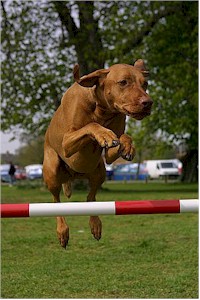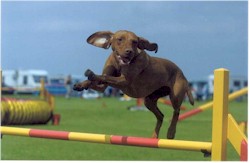In a nutshell: An attractive medium sized
intelligent, lively and affectionate gundog
 Physical
description of dog: The Vizsla is a russet gold short-haired dog of pointer type.
The eyes are deep amber in colour.
The nose, lips and toe nails are of similar colour to the coat.
The tail is customarily docked, one third off, to avoid damage whilst working in
thick cover.
Height at the withers is 53-60cms for bitches and 57-64cms for dogs.
Weight range is between 20-30 kilos.
Physical
description of dog: The Vizsla is a russet gold short-haired dog of pointer type.
The eyes are deep amber in colour.
The nose, lips and toe nails are of similar colour to the coat.
The tail is customarily docked, one third off, to avoid damage whilst working in
thick cover.
Height at the withers is 53-60cms for bitches and 57-64cms for dogs.
Weight range is between 20-30 kilos.
Temperament: The Vizsla is a
sensitive dog, which responds to firm but gentle handling.
A rough handler will never succeed. As a
breed they are extremely vivacious, affectionate and need plenty of individual attention
and exercise.
Advantages as an agility dog:
-
Enthusiastic and trainable, wanting to please.
-
Boundless energy.
-
Mix well in the company of other dogs.
-
Capable of tight turns
-
Agility keeps Vizslas lean and fit
 Disadvantages
as an agility dog:
Disadvantages
as an agility dog:
-
A long striding dog which consequently may result in
missing contacts
-
An enthusiastic Vizsla (males in particular) can be
noisy when competing.
-
Due to their sensitive nature, they can easily switch
off if chastised or given too much repetitive work.
Rating out of 10 as an agility dog (be honest) and why:
Depends if you’re rating them against a Border Collie or WSD. Against these probably a
7/10, amongst other breeds. Although trainable and agile, as a generalisation they do not
have the speed of a Belgian Shepherd. However, they are likely to be more steady,
directable and steerable than, for instance, a Lurcher.
Probably not a first choice if buying solely as an agility dog.
 Examples
of dogs that have done well in agility: Tragus Coppermill
(Chester) has qualified twice for the Pedigree ABC Final at Tatton Park.
Competed at Crufts in the ABC invitation event.
Qualified for Barbour pairs and twice for Agility Club pairs Final.
Both Kate Griffiths’ Aurichalcum Enigma (Hebe) and Andrea Russ’ Gardenway L’Escargot
(also called Chester) have gone on to Olympia and Crufts from the ABC Final
Examples
of dogs that have done well in agility: Tragus Coppermill
(Chester) has qualified twice for the Pedigree ABC Final at Tatton Park.
Competed at Crufts in the ABC invitation event.
Qualified for Barbour pairs and twice for Agility Club pairs Final.
Both Kate Griffiths’ Aurichalcum Enigma (Hebe) and Andrea Russ’ Gardenway L’Escargot
(also called Chester) have gone on to Olympia and Crufts from the ABC Final
What's it like to live with as a pet:?
They keep you active and trim as they need plenty of exercise. Provided they
have free exercise, they are content to settle down in the house – ideally on a comfortable
settee or given the chance in bed under a duvet! Good company as they like to be near you
as much as possible. Good guard dog.
Would you buy another one for agility?
Yes. I am happy living with them first and foremost as pets in the home and
wouldn’t want a longhaired breed. I know I’m not fast enough in mind or body to compete
with a (good) collie.
Source: Liz Stedman
From Paula Triggs
I
thought the article on ABC's was excellent, in particular Liz Stedman's review on Hungarian
Vizsla's which describes them perfectly even down to the 'vocal males'! Needless to say my
Ross is one of the noisy ones whose enthusiastic woofing can be heard all the way round the
course!
From Kate Prosser...
I think this is a very fair and objective
view of Vizslas as an agility dog and really sums them up.
I
probably would have been a lot more partisan as I think they are the best breed about! To
prove the point. I now have four competing Vizslas three bred by me - all of which have
been well placed in Novice/Iintermediate. My 'oldie' at eight is having her best season yet
and has qualified for the ABC final for her third year running - along with her daughter,
Anya Beagle (shown in top picture) this year.
They are a very gentle breed but one that needs firm handling or they will take the mick.
One more thing - one top agility Vizsla not mentioned is Karen Nixon's late
but great Mahogany Floyd. A star in every sense of the word, he gave every round he ever
did absolutely everything, but it might not always have been what the judge or Karen had in mind! This is what competing with a viz is all about.
Photo: Nick Ridley